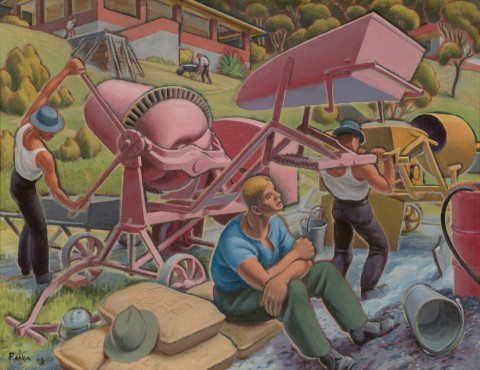CONCRETE MIXERS, 1946
WEAVER HAWKINS
oil on composition board
60.0 x 77.5 cm
signed and dated lower left: Raokin 46
Private collection, Sydney
Private collection, Sydney, acquired in the 1970s
Eighth Annual Interstate Exhibition, Contemporary Art Society, Education Galleries, Sydney, 12 – 28 November 1946, cat. 68
In Concrete mixers, 1946, Weaver Hawkins captures one moment in the building boom in Australia’s suburbs caused by the housing shortage that followed the end of World War Two. Hawkins and his family had arrived in Sydney in 1935 and settled soon after in the bushland suburb of Mona Vale, bracketed by Pittwater at its north-west and a long surf beach to its east. The section of Waterview Street that they lived in soon became known as ‘the mad half mile’ due to its concentration of artists, writers and actors, including Rah Fizelle, Arthur Murch (who lived next door between 1941 and 1943), and Peter Finch’s family around the corner. Hawkins’ family also soon became close friends with that of the artist couple Frank and Margel Hinder. It was the perfect environment for him as Hawkins had experienced a highly unusual upbringing in England with Victorian liberalists as parents. He wore his own hand-crafted leather sandals and never donned a tie, proclaiming ‘we are rationalists, socialists and nonconformists.’1 His wife Irene was also a freethinker and they had spent more than a decade prior to Australia travelling and living in several countries in Europe and the Pacific.
Hawkins first studied and exhibited in the years leading up to World War One and was greatly inspired by the Vorticist movement’s use of angularity and compositional dynamics. During the war, however, Hawkins was horribly wounded leaving him with two withered arms; only the left hand was (just) capable of holding a brush. Nonetheless, he doggedly retrained to be able to sketch and paint again, an almost miraculous feat achieved over an eighteen-month period. He returned to exhibiting but, annoyed at the attraction his art now gained due to his injuries, he began signing his name ‘Raokin’, a play on an Italian mispronunciation of his name. Apart from Vorticism, he was also fascinated by alternate theories including dynamic symmetry, Platonic solids, and magic squares.2 The first works to successfully align these influences date from the mid-1920s when he was exhibiting in British groups shows which included Vorticism’s founder Wyndham Lewis. Hawkins’ paintings include a number of intimate studies of his domestic life as well as charged, sinuous landscapes, but he was also attracted to ‘subjects of strenuous work and play. [I]t was his tough mind which chiefly created order out of chaos in works which he hoped might help to make the world a better place.’3 In Concrete mixers, the physicality of the scene would have included noise, oaths, sweat and fumes; yet Hawkins’ skill at design – his ordering of the ‘chaos’ – results in an image that elegantly charts the progress of the workers, from first pour of the concrete, though to toiling up the hill with a wheelbarrow, and finally, the return for a well-earned breather. His colours, dominated by a radiant pink, enliven the experience.
Hawkins exhibited Concrete mixers at the Contemporary Arts Society (CAS) in Sydney shortly after its completion. Titled Eighth Annual Interstate Exhibition, this was one of the first post-war gatherings of CAS artists from across the country, an extraordinary collective statement which included Arthur Boyd, Sidney Nolan, Jean Bellette, Margaret Olley, and many others.
1. Thomas, D., 'Hawkins, Harold Frederick (1893 – 1977)', Australian Dictionary of Biography, National Centre of Biography, Australian National University, https://adb.anu.edu.au/biography/hawkins-harold-frederick-10457/text18547, published first in hardcopy 1996, accessed online 18 March 2022.
2. See ‘Thomas, D., ‘Weaver Hawkins’, Project 11: Weaver Hawkins, Art Gallery of New South Wales, Sydney, 7 February – 14 March 1976
3. Thomas, D., 'Hawkins, Harold Frederick (1893 – 1977)', op. cit.
ANDREW GAYNOR
